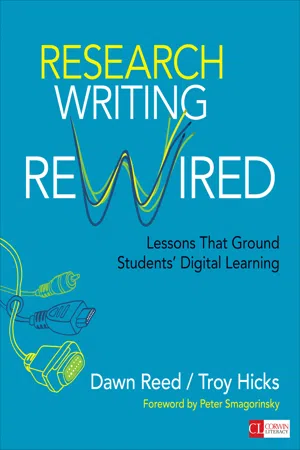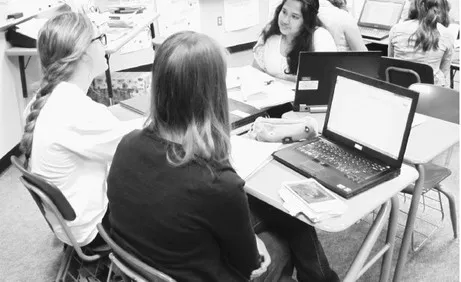
eBook - ePub
Research Writing Rewired
Lessons That Ground Students' Digital Learning
This is a test
- 264 pages
- English
- ePUB (mobile friendly)
- Available on iOS & Android
eBook - ePub
Book details
Book preview
Table of contents
Citations
About This Book
Research shows that only half of teachers say digital tools make writing instruction easier... Research Writing Rewired shows us how to channel students’ passion for digital communication into meeting our goals, and provides a vision for teaching English in today’s classroom. The authors provide you with a clear model for tech-rich research that will inform your own units. Guiding components include:
- An inquiry-based, technology-rich unit
- 28 model lessons and a framework including extensions, tech tips, and activities
- Best practices on formative assessment, close reading, and think alouds
- Activities built around students’ favorite technology
- QR codes to video clips on a companion website
Frequently asked questions
At the moment all of our mobile-responsive ePub books are available to download via the app. Most of our PDFs are also available to download and we're working on making the final remaining ones downloadable now. Learn more here.
Both plans give you full access to the library and all of Perlego’s features. The only differences are the price and subscription period: With the annual plan you’ll save around 30% compared to 12 months on the monthly plan.
We are an online textbook subscription service, where you can get access to an entire online library for less than the price of a single book per month. With over 1 million books across 1000+ topics, we’ve got you covered! Learn more here.
Look out for the read-aloud symbol on your next book to see if you can listen to it. The read-aloud tool reads text aloud for you, highlighting the text as it is being read. You can pause it, speed it up and slow it down. Learn more here.
Yes, you can access Research Writing Rewired by Dawn M. Reed, Troy W. Hicks in PDF and/or ePUB format, as well as other popular books in Didattica & Didattica generale. We have over one million books available in our catalogue for you to explore.
Information
1 Introducing Research, Inquiry, and Connected Learning
Research is formalized curiosity. It is poking and prying with a purpose.—Zora Neale Hurston

No matter who we ask to think about the concept of culture, no matter what point they are at in their lives, it is a big issue to grapple with, to puzzle through. Asking ninth graders to think about it, especially at 7:45 in the morning, initially results in general bewilderment. This chapter shows how we effectively introduced students to the research, inquiry, and technology tools we used in the unit “Reading Our World and Exploring Perspectives: Identity and Culture.”
As we considered how best to frame this broad idea and help students break the work into manageable chunks, we identified a number of overlapping goals:
- Integrate technology in a robust and appropriate manner
- Invite students to begin their own inquiry process
- Teach students how to participate in a variety of digital spaces as productive digital citizens
We aimed to develop a shared sense of artifacts of culture, which we referred to as representations of a cultural characteristic (art, music, fashion, food, traditions, language, etc.), and characteristics of culture, which we referred to as abstract and metaphorical or “thinking about culture” (e.g., the trait of being individualistic).
In terms of technology, we introduced or reminded students of the following technologies:
- Wikispaces, our class site for this work, including daily agendas with links and handouts
- The Youth Voices social network, where students would post their blogs and respond to the posts of others
- Google Apps for Education, including Drive, Docs, and Slides, for collaborative work to share ideas, comment on one another’s work, and compose together
We also explored digital citizenship, asking students to think about how they represented themselves in existing online spaces, such as social networks outside of school, and how they could create academically appropriate—yet still personal—digital identities related to topics inspired through work in school. As we consider the ways in which this approach rewires the research and writing process, we encourage you to pay particular attention to the ways that students develop their own interest-driven questions, how they join a personal learning network of other engaged students, and how they use technology to explore and annotate texts.
For their inquiry, we asked students to think about big questions focused on identity and culture, knowing that some would “wobble” with the ideas being presented. As Fecho (2013) notes,
as teachers and students venture into dialogically primed spaces, they often do so with questions and doubt. It is in such spaces where . . . wobble (Fecho, 2011) happens, an indication that change is occurring and attention should be paid. (p. 117)
These moments where students—and teachers—“wobble” are important for learning, as we grapple with big questions and consider, explicitly, what we are learning and why we are learning it.
Charles Fort in Wild Talents (1998) wrote, “One can’t learn much and also be comfortable.” Challenges that initially feel uncomfortable can be a key part of learning. This is the “wobble,” or the moment when students are grappling with a big idea and not always getting it. Serious writers and professionals in other contexts often wrestle with such moments of uncertainty. It reflects critical thinking and real-life learning. But to establish a classroom for teachable moments that are uncomfortable, we need to be ready for mess and ready for challenges.
This chapter spans the first section of the unit, from the Preview Lesson through Lesson 5. We want to remind our readers that, in addition to the lesson outlines, links to all handouts and resources referenced in this book are available on the companion website, http://resources.corwin.com/writingrewired.
Beginning in this chapter and continuing through Chapter 5, we will share each lesson, including its purpose, its context within the inquiry unit, a handout for the lesson, and extensions and adaptations for consideration.
Preview Lesson: Thinking Through a Cultural Lens
The purpose of this lesson is to help students
- Define and begin to establish a shared thinking space
- Explore artifacts that represent a culture and offer a tangible connection to the culture’s characteristics
- Determine characteristics of culture and analyze abstract and metaphorical characteristics of a culture
- Engage in initial brainstorming of cultural images based on student perception
- Preread key ideas for the unit of study
Reading and Responding to a Common Text
To introduce the inquiry unit, we asked students to read the transcript while viewing Sheikha Al Mayassa’s (2010) TED Talk Globalizing the Local, Localizing the Global. (The transcript for many TED Talks can be accessed by clicking on a visible link on each video page: “View interactive transcript.”) In this TED Talk, Al Mayassa explores the cultural identity of Qatar through examples of fashion, food, and technology. In this conversation, she additionally breaks down the importance of gender roles in understanding and disseminating cultural identity. When we selected this video, we recognized that Al Mayassa’s talk is quite hefty in terms of both the type and number of ideas, especially for ninth graders, but we wanted to present students with a text that addressed our cultural focus, as well as challenged them so that they knew we would be working at a high level of sophistication in our conversation.
As we introduced this TED Talk, we invited the students to read and listen for the general messages and concepts presented about culture, not to understand every detail of Al Mayassa’s presentation. After they viewed the video, we asked them to write and reflect on the speech and then discuss it. Through class discussion, we captured ideas from Al Mayassa’s transcript and posted them in the discussion tab of our unit culture study wiki, as this website served as a class hub across all the sections of Dawn’s courses; when students posted on this site, students in all class sections could observe ideas expressed by students from Dawn’s other classes who were also studying this talk. For instance, some students identified cultural artifacts in Al Mayassa’s speech—fashion, religion, tradition, food, mobile phones, and social media—and others found smart ideas as points to share, such as how sometimes cultures are misunderstood. In some cases, students latched on to key phrases, and in other instances, they were able to identify characteristics and artifacts of culture such as Al Mayassa’s abaya (traditional dress), the role of women in a traditionally patriarchal culture, and new representations and interpretations of art. Al Mayassa also poses important questions that the students pointed out, including “What should culture in the 21st century look like?”
Reflective Writing and Thinking: Generating Initial Ideas
After exploring this initial text for our cultural study, we prompted students to engage in a quick activity of collecting images for their own TED Talk. By asking students to identify five images that represent a culture, we intentionally created a task that was both quick and thought-provoking. We also set up the exercise to provoke cognitive dissonance as students “wobbled” with questions related to culture, such as “What is culture?” and “How do we participate in it?” We explained that their goal for the assignment was to capture quick first impressions of a culture so they could, by the end of the inquiry unit, have an artifact to return to as a reminder of their initial thinking related to culture.
During this activity, a student turned to Dawn and asked, “What are we doing? What will we do with this work?” He understood that this first assignment involved selecting images and participating in a conversation related to culture, but he wanted Dawn to identify the final destination. What would the end product be? Dawn replied, “We’re going to be exploring culture and our questions related to culture. We’ll be on a journey of inquiry together.” To succeed as researchers, students must learn to be comfortable embarking on journeys for the purpose of exploration without a prescribed final destination as the main goal. Of course, we had the end goal in mind, but we also intentionally were building in flexibility and intentional time to question and explore without a scripted response or format. After all, research should impact our thinking, and a predetermined idea is not being informed by research, just proven.
Still others didn’t jump ahead to try to determine the major end product but rather grappled with what culture to represent and whether or not to include an image related to a culture that they belonged to but did not participate in. For instance, one student recognized that while fast food plays an important role in American culture, she did not eat it. In that sense, the conversation among students was even better than we had expected. Students started asking questions: “Should I just represent American culture?” “Should it be my ethnic culture?” “Can it just be teenage culture?”
Initially, the students wanted us to answer these questions for them. Instead, we expla...
Table of contents
- Cover
- Acknowledgements
- Title Page
- Copyright Page
- Contents
- At-a-Glance Lesson Summaries
- Foreword
- Acknowledgments
- Preface Reading, Writing, and Inquiry With Adolescents
- Acknowledgements
- Introduction Framing Student Inquiry
- 1 Introducing Research, Inquiry, and Connected Learning
- 2 Getting Started With Inquiry Work Visual Literacy and Literature Circles
- 3 Laying the Groundwork for Research Writing Developing Close Reading Skills and Organizing Digital Spaces
- 4 Embarking on the Inquiry-Based Research Essay Collaboration, Citation, and Credibility
- 5 Writing Workshop and Media Projects Responding, Revising, and Reflecting
- 6 Final Reflections and Conclusions
- References
- Index
- About The Authors
- Publisher Note
- Publisher Note